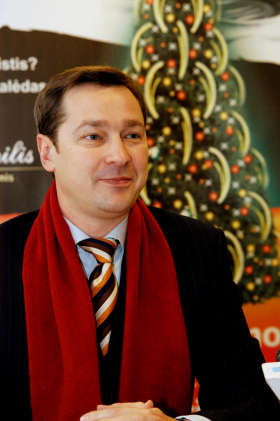Living Nativity Scene and Europa Christmas Tree, December 20, 2006

Arturas Zuokas - Mayor of Vilnius
Following these festivities in the home, many families attend Midnight Mass. The very moving Christmas service celebrated by Franciscan monks in St. Bernhard’s Church (Šv. Pranciškaus ir Bernardinų bažnyčia) in Vilnius is always very well attended. Straw covers the floor of the entire church, which was desecrated during the Soviet era and converted into a workshop. The renovations have still not been completed. During the Soviet occupation, there was a ban on celebrating Christmas officially. One of the church’s alcoves serves as a makeshift stall for live sheep and donkeys.
Each year since 1999, Vilnius’ 326-meter TV broadcasting tower is adorned with countless lights to turn it into an tree during the Christmas season and such is a yearly attraction.
From the beginning of December until the Feast of the Epiphany in early January, prominent features in Vilnius’ cityscape are the Christmas lighting along the downtown pedestrian mall and the two artistically adorned Christmas trees in front of the cathedral (Arkikatedra bazilika) and the Old City Hall (Pirmoji Rotušė). The latter assumes particular importance this year. On the evening of December 7, two identical Lithuanian Christmas trees were simultaneously illuminated in a blaze of red and golden light: one on Vilnius’ City Hall Square (Rotušė aikštė) and its twin on Smithfield Square in Ireland’s capital city, Dublin. The live telecast of the event in Lithuania and Ireland was entitled “TV Bridge,” across which the mayors of both cities as well as many friends and relatives “could look one another in the eyes across the many kilometers separating them” and exchange Christmas greetings. There are currently about 120,000 Lithuanians living in Ireland, mostly in Dublin. This Christmas tree serving as an ambassador of Vilnius – European Capital of Culture consists of natural and artificial boughs mounted on a steel framework. It will continue on its journey through Europe over the next three years, spending Christmas 2007 in London, 2008 on the Place de l'Hôtel-de-Ville in Paris before reaching its final destination in 2009: Linz, where it will be a brilliantly lustrous symbol of the friendship linking together Europe’s joint Capitals of Culture. This sense of attachment was expressed recently in a letter communicating Christmas and New Year’s greetings from Vilnius Mayor Artūras Zuokas:
Dear people of Linz,
I do thank you for being together, for being partners this year.
I wish your Christmas is bright with joy and warm with love.
Have a successful, prosperous and peaceful New Year!
Sincerely
Artūras Zuokas, Mayor of Vilnius
By the way: Beginning January 1, 2007, a total smoking ban goes into effect in Lithuania in all public buildings, educational institutions, sports facilities and event venues as well as in restaurants, cafés, bars and discos. Violators face fines between 1,000 and 5,000 litas (290-1,450 euros).
Translation commissioned by Linz09





